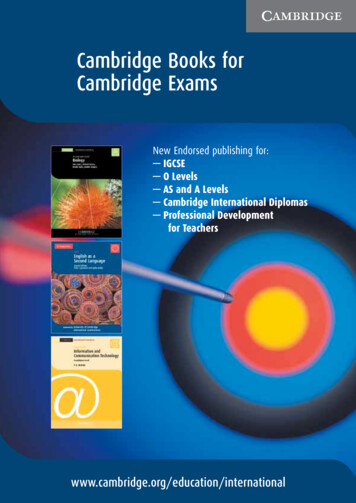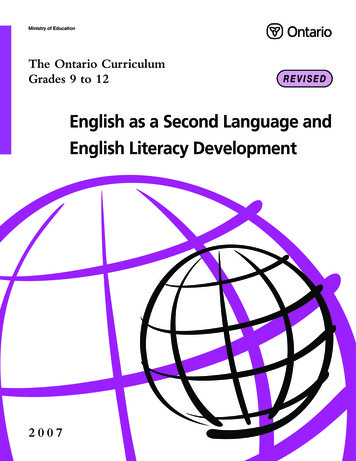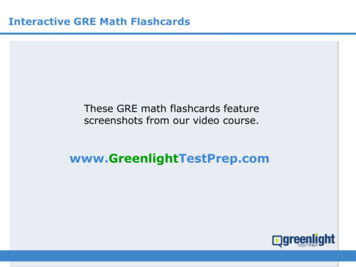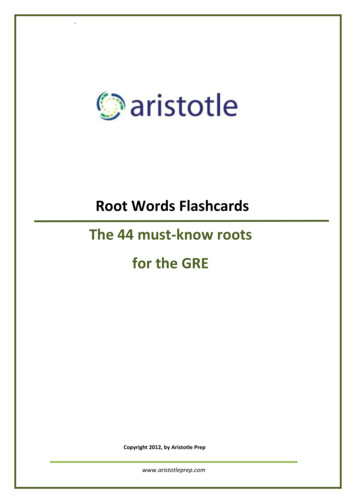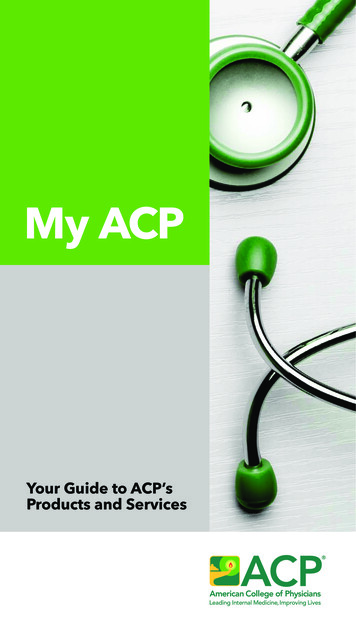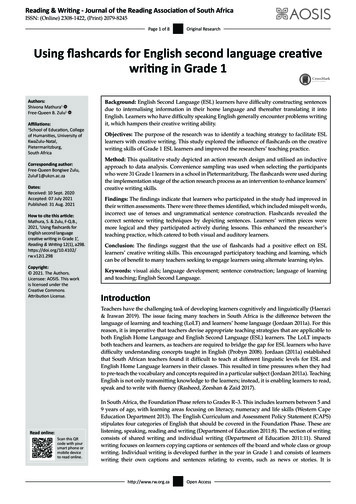
Transcription
Reading & Writing - Journal of the Reading Association of South AfricaISSN: (Online) 2308-1422, (Print) 2079-8245Page 1 of 8Original ResearchUsing flashcards for English second language creativewriting in Grade 1Authors:Shivona Mathura1Free-Queen B. Zulu1Affiliations:1School of Education, Collegeof Humanities, University ofKwaZulu-Natal,Pietermaritzburg,South AfricaCorresponding author:Free-Queen Bongiwe Zulu,ZuluF1@ukzn.ac.zaDates:Received: 10 Sept. 2020Accepted: 07 July 2021Published: 31 Aug. 2021How to cite this article:Mathura, S. & Zulu, F-Q.B.,2021, ‘Using flashcards forEnglish second languagecreative writing in Grade 1’,Reading & Writing 12(1), : 2021. The Authors.Licensee: AOSIS. This workis licensed under theCreative CommonsAttribution License.Background: English Second Language (ESL) learners have difficulty constructing sentencesdue to internalising information in their home language and thereafter translating it intoEnglish. Learners who have difficulty speaking English generally encounter problems writingit, which hampers their creative writing ability.Objectives: The purpose of the research was to identify a teaching strategy to facilitate ESLlearners with creative writing. This study explored the influence of flashcards on the creativewriting skills of Grade 1 ESL learners and improved the researchers’ teaching practice.Method: This qualitative study depicted an action research design and utilised an inductiveapproach to data analysis. Convenience sampling was used when selecting the participantswho were 31 Grade 1 learners in a school in Pietermaritzburg. The flashcards were used duringthe implementation stage of the action research process as an intervention to enhance learners’creative writing skills.Findings: The findings indicate that learners who participated in the study had improved intheir written assessments. There were three themes identified, which included misspelt words,incorrect use of tenses and ungrammatical sentence construction. Flashcards revealed thecorrect sentence writing techniques by depicting sentences. Learners’ written pieces weremore logical and they participated actively during lessons. This enhanced the researcher’steaching practice, which catered to both visual and auditory learners.Conclusion: The findings suggest that the use of flashcards had a positive effect on ESLlearners’ creative writing skills. This encouraged participatory teaching and learning, whichcan be of benefit to many teachers seeking to engage learners using alternate learning styles.Keywords: visual aids; language development; sentence construction; language of learningand teaching; English Second Language.IntroductionTeachers have the challenging task of developing learners cognitively and linguistically (Haerazi& Irawan 2019). The issue facing many teachers in South Africa is the difference between thelanguage of learning and teaching (LoLT) and learners’ home language (Jordaan 2011a). For thisreason, it is imperative that teachers devise appropriate teaching strategies that are applicable toboth English Home Language and English Second Language (ESL) learners. The LoLT impactsboth teachers and learners, as teachers are required to bridge the gap for ESL learners who havedifficulty understanding concepts taught in English (Probyn 2008). Jordaan (2011a) establishedthat South African teachers found it difficult to teach at different linguistic levels for ESL andEnglish Home Language learners in their classes. This resulted in time pressures when they hadto pre-teach the vocabulary and concepts required in a particular subject (Jordaan 2011a). TeachingEnglish is not only transmitting knowledge to the learners; instead, it is enabling learners to read,speak and to write with fluency (Rasheed, Zeeshan & Zaid 2017).Read online:Scan this QRcode with yoursmart phone ormobile deviceto read online.In South Africa, the Foundation Phase refers to Grades R–3. This includes learners between 5 and9 years of age, with learning areas focusing on literacy, numeracy and life skills (Western CapeEducation Department 2013). The English Curriculum and Assessment Policy Statement (CAPS)stipulates four categories of English that should be covered in the Foundation Phase. These arelistening, speaking, reading and writing (Department of Education 2011:8). The section of writingconsists of shared writing and individual writing (Department of Education 2011:11). Sharedwriting focuses on learners copying captions or sentences off the board and whole class or groupwriting. Individual writing is developed further in the year in Grade 1 and consists of learnerswriting their own captions and sentences relating to events, such as news or stories. It ishttp://www.rw.org.zaOpen Access
Page 2 of 8challenging to adopt appropriate teaching strategies withinthe classroom when teaching learners creative writing skills.‘Children begin Grade 1 by “writing” using pictures but asthey master the skills of letter formation they can start tocopy individual words, captions and full sentences’(Department of Education 2011:18).In Grade 1, creative writing is entry-level story writing,which falls under individual writing outlined in the CAPSdocument. ‘The idea of creative writing should fosterchildren’s background; it should inspire them to use theirown experience to create and to convey themselves’ (Nino &Paez 2018:104). Creative writing becomes meaningful whenlearners understand the concept of story writing, as well asthe vocabulary needed to accomplish this task (Mukoroli2011). The challenge is when ESL learners have difficulty inunderstanding the LoLT when it is not their home language(Jordaan 2011a). This challenge is more pronounced in anEnglish medium school with the majority of the learnersbeing ESL learners. The participants in this study consistedof both ESL and English Home Language learners, while theresearch site is an English medium school. To address thischallenge, teachers should try to relate new vocabularyneeded for creative writing activities to everyday life orpresent visual aids to assist the ESL learners’ understandingprocess. Jordaan (2011b) mentioned that there is limitedresearch on the development of language skills of SouthAfrican learners, particularly in the Foundation Phase. In linewith this statement, Sitompul (2013) found that research onusing flashcards to teach young learners’ vocabulary was stillrare. Flashcards can be used as visual prompts to promotethe recognition of sight words in reading and vocabularyextension, and to improve learners’ creative writing skills byproviding context for new words introduced to learners(Muhammad, Almas & Muhammad 2016; Mukoroli 2011;Nugroho, Nurkamto, Sulistyowati 2012). Vocabulary orword flashcards can be used to teach the spelling of newlylearnt words, which can aid learners’ reading and writingskills (Komachali & Khodareza 2012). Flashcards encourageactive participation in lessons by both learners and teachers,which fosters an interactive learning environment (Nugrohoet al. 2012).A number of external professional development initiativesare available for South African teachers such as short courses,workshops and university qualifications. However, there isstill a need for research that supports teacher inquiry as aform of professional development (Manfra 2019). Teacherinquiry as a form of professional development involvesteachers taking responsibility for their own learning, situatinglearning in their own classrooms and linking it to theirpractice (Manfra 2019). Teacher inquiry is a ‘transformativemodel’ (Kennedy 2014:347) of professional development thatprovides a platform for teacher learning. Teacher learning inan inquiry perspective deals with the challenges related toteacher learning from cognitive and practical perspectivesincluding the need for teachers to implement problemsolving skills and rethink practices that have proven to beunsuccessful in the classroom (Manfra 2019). This article thushttp://www.rw.org.zaOriginal Researchpresents an action research on how flashcards were used toteach creative writing to ESL learners in Grade 1.Purpose of the studyThe purpose of this action research was to explore theinfluence of flashcards on the creative writing skills of ESLGrade 1 learners. Using flashcards in the classroom as a toolmay aid writing and be of benefit to learners. Using actionresearch was beneficial to identify a viable teaching strategyto improve instructional practices. The research questionaddressed by this action research study was: How does theuse of flashcards as a teaching strategy enhance writing skillsof ESL Grade 1 learners?Literature review and thetheoretical framework of the studyWriting is a skill that is developed at an early phase oflanguage education and is vital in the teaching and learningprocess (Muhammad et al. 2016). Similarly, Nino and Paez(2018:111) mentioned that ‘writing is a skill that can bedeveloped from different creative ways as children enjoygames and use their imagination to contrast with reality’.When writing, students activate their ‘cognitive, linguisticand cultural aspect in their mind’ (Haerazi & Irawan 2019:10).Creative writing is introduced in Grade 1 and the foundationis laid for learners’ future academic writing. Writingproficiency can be hindered or enhanced by both teachersand learners (Muhammad et al. 2016). Teachers need toprompt learners and provide adequate motivation andfeedback, while learners need to be enthusiastic about theirlearning (Muhammad et al. 2016). For the purpose of thestudy, the prompts that were used to aid learners’ writingwere flashcards, consisting of words that can be used to makesentences. An example is the beginning words of the sentence‘I went to’ or ‘I have a’. These phrases served as prompts forlearners when they started their creative writing process.Flashcards are cards that contain either pictures or words,which serve as visual aids for learners (Adas & Bakir 2013;Baleghizadeh & Ashoori 2011; Komachali & Khodareza 2012;Sartika 2020). They can be used to help learners identifyspelling and contexts of words and in this way aid learners intheir writing abilities (Bloch 1999; Sartika 2020; Skarr et al.2012). As stated by Adas and Bakir (2013), repetitive exposureto material is beneficial to ESL learners. Learners can storewords that they have been repeatedly exposed to and retrievethese words from their memory immediately (Miles & Ehri2017). Having knowledge of the vocabulary needed andbeing familiar with it can make the task of writing easier(Mukoroli 2011). Studies (Aulia 2018; Harisanty et al. 2020;Skarr et al. 2012) on teaching creative writing using flashcardssuggest that it has many advantages in language teaching.These include consolidating vocabulary, and motivatinglearners by gaining interest. They can be used for any agegroup or ability group of learners, are portable and can beused at any time, can be arranged to create logical groupingof the target words, are cost effective, provide a visual link toOpen Access
Page 3 of 8second language learners and can be used for practisingstructure and word order or for a variety of games (Haycraft1978; Nugroho et al. 2012; Skarr et al. 2012). ‘Besidesincreasing student vocabulary, flashcards can also be used toimprove foreign language understanding’ (Harisanty et al.2020:4). Flashcards containing pictures have the ability toprovide meaning to abstract concepts encountered by ESLlearners (Sartika 2020). According to Aulia (2018), flashcardsallow teachers to explain concepts and provide a variation inteaching strategies in a classroom setting. Using flashcardsmay enable teachers to present learning materials ininteresting ways, while aiding learners’ understanding ofteachers’ explanations (Sartika 2020).This study is informed by situated learning theory. Severalresearchers such as Brown, Collins and Duguid (1989);Scardamalia and Bereiter (1985); Durning and Artino (2011),Lave and Wenger (1991), and Putnam and Borko (2000) havesupported this theory. The theory is underpinned by threecognitions, namely ‘cognition as situated, cognition as socialand cognition as distributed’ (Putnam & Borko 2000:4).Putnam and Borko argued that the situated learning theoryallows for multiple conceptual perspectives and multiple(individual and sociocultural) units of analysis. Thesemultiple perspectives thus provide powerful tools forunderstanding student learning in a classroom setting. Thistheory suggests that learning is constantly taking place in theclassroom, due to teachers learning through practice, as wellas social and cultural factors that influence learning andteaching (Putnam & Borko 2000). A study based on writingdone by Scardamalia and Bereiter (1985) used this theory todevelop prompts they called procedural facilitation whichaided learners in their writing process (Collins, Brown &Newman 1987). This approach provided prompts andmodelling of expert processes for the learners, whilegradually minimising support and allowing learners to writewithout guidance. In this study, flashcards were used toprompt learners in their elementary stages of writing byproviding the basic words utilised in creative writing. Thisfacilitated learners’ creative writing process and promotedconfidence in word recognition.When using situated learning theory, the context in whichlearning occurs is fundamental, and the manner in whichlearning takes place is based on the situation (Anderson,Reder & Simon 1996). This theory is relevant to this studydue to the fact that learners’ social contexts determine theirhome language. The location of the school determinesteachers’ LoLT when teaching writing, as this is dependenton the surrounding residents and the common spokenlanguage. As stated by Anderson et al. (1996), emphasisneeds to be placed on what is learnt in the classroom andwhat is required outside the classroom. During the research,flashcards were used in reading groups, as this allowed formore focused sessions, with smaller numbers. Readinggroups are based on learners’ academic ability and thereforelearners of similar intellectual capacity were groupedtogether. This enabled the researcher (Author 1) to identifyhttp://www.rw.org.zaOriginal Researchlearners who had difficulty with word recognition andcreative writing.MethodologyResearch paradigmConsidering that action research is used for improvingteaching practice as part of a process of change (Koshy,Koshy & Waterman 2010), this study is thus located withinthe critical paradigm. Cohen, Manion and Morrison (2011)explain that the critical paradigm acknowledges ideologicaland political contexts of educational research and aims toemancipate individuals. This action research study is thusemancipatory due to changing conditions which hamperdesired improvement in classroom practices. We argue thatconducting this action research is a ‘transformativeprofessional development’ (Kennedy 2014:689) activitywhich is liberated from the imposed activities of the schoolmanagement team or Department of Basic Education officials.Furthermore, the first author of this article reflected on herteaching practice and designed an intervention that aimed tochange and transform her teaching practice. Bertram andChristiansen (2014:27) state that ‘the critical paradigm seesreality as shaped by social, political, cultural, economic andother dynamics’. In relation to this study, social and culturalbackgrounds foreground learners’ language. Learners’ homelanguage is also dependent on their socialisation andupbringing. By changing teaching strategies, learners’academic writing improved, which was beneficial to both theeducator and the learners. Using flashcards was of benefit tothose learners who learn visually, as the words were seenand associations made. By experimenting with a newteaching strategy in order to assist Grade 1 ESL learners andchange the focus of standardised writing approaches, theresearchers’ teaching practice was improved.Research siteThis action research study was conducted in a primary schoollocated in the uMgungundlovu district in KwaZulu-Natal.The school in which the study was undertaken is classified asa quintile 5 school. This is also one of the ex-Model C schools,which accounts for the school being well-resourced, due tothe majority of school funding being received from schoolfees and fundraising activities, with minimal funding fromgovernment. A large number of the learners at the school,where the action research was conducted, are ESL learnersfrom surrounding urban areas in Pietermaritzburg, with themajority speaking isiZulu as their home language. The LoLTof this school is English and therefore all lessons are deliveredin English.SamplingConvenience sampling was used in this study, due tomembers of the target population meeting certain criteria,such as easy accessibility, geographical proximity, availabilityat a given time, or the willingness to participate (Cohen,Manion & Morrison 2011; Etikan, Musa & Alkassim 2016).Open Access
Page 4 of 8This method of sampling is used for the benefit of theresearcher, as the sample is easily accessible (Bertram &Christiansen 2014). The sample consisted of 31 Grade 1learners within the age range of 6–7 years. The researcher(Author 1) intended to use flash cards to enhance theircreative writing skills.MethodAction research consists of four steps, namely (1) planning,(2) implementation, (3) observation, and (4) reflection(Bertram & Christiansen 2014). Planning includes thepreparation of all the materials needed for the action research,including lesson plans and materials (Nugroho et al. 2012).The planning stage included a week of observation oflearners’ sentence construction and the preparation offlashcards to facilitate their writing skills. The lesson plansfor the 6 weeks of research were also planned during the firstweek. A baseline assessment was carried out in the form of awritten task, where learners had to write four sentencesbased on their June holiday experience. The learners who didnot understand the concept of sentence writing merely wrotewords, some of which were unidentifiable. Flashcards wereprinted in text boxes, and thereafter cut out and pasted ontocardboard, which was then laminated. Implementationrequires the researcher to take action and execute the planformulated in the previous step. Within the second stage,flashcards were used 3–4 times a week to help learners graspthe spelling and identification of words that can be used intheir creative writing. Learners were given creative writingactivities to complete each week. During week 5, learners didnot complete a written activity due to a public holiday andtime constraints. Observation is defined as the researchermonitoring the effects of the action research in its context(Nugroho et al. 2012). In step 3, the learners’ sentence writingskills were observed again, at the end of the 6-week cycle, toidentify if any improvements had occurred. The flashcardswere also evaluated within the fifth week of the research andnew words were added due to a need that was identified.These words were common words that are used in creativewriting tasks. The function of reflection is to determine thestrengths and weaknesses of the research and whether it hasbeen successful (Nugroho et al. 2012). Within the last stage,reflection on the efficacy of flashcards on improving ESLlearners writing was carried out and the determination ofwhether this method should be employed or changed infuture, as well as whether a new cycle of action researchneeded to be carried out.Original Researchwas identified and a baseline assessment was conducted.Informal assessment was also conducted in each week whilelearners were performing their creative writing tasks, as wellas while the flashcards were being used in the classroom. Theobservations, research notes documented, and evidencegathered from learner books determine whether the wordsflashed to learners generated any change in their writingpatterns. Document analysis included learners’ work books,tests and exercise books, which were analysed to comparesentences written before and after the use of flashcards.Data analysisAn inductive approach to data analysis was used in thisstudy. Inductive analysis begins with observations, raw datacollection and pattern detection to reach the development ofgeneral conclusions (Bertram & Christiansen 2014:117). Thefirst step of the analysis involved observation of learnersduring lessons. Within the second step, which is the raw datacollection, the initial baseline assessments of learners’ writingwere inspected and thereafter the creative writing activitiesperformed by learners each week were assessed to identify ifany patterns occurred with the words being flashed and thewords used by learners within their creative writing. Withinthe third step of the analysis, themes were detected andidentified after comparing learner books and findingcommon mistakes.Designing an action research project raises complex ethicalissues (Nolen & Putten 2007:402). In line with Nolen andPutten (2007) principles of ethical issues (informed consent,protecting the confidentiality of participants, autonomy ofparticipants) and the South African Council for Educators(SACE) ethical standards for teachers were followed. Relevantgatekeepers’ permission for the study to be undertaken wasobtained and autonomy of participants were considered, aspermission from the school principal was obtained along withpermission from parents for learners to participate in thestudy. In place of names, pseudonyms were used to ensurethat the school and participants remain anonymous. Accordingto Bertram and Christiansen (2014) beneficence refers toresearch being of benefit and therefore it is reflected in thisstudy, as the findings benefited learners and the researcher.Results and discussionData collectionDuring the observation, it was noted that some learners wereunable to construct a single sentence, even with guidance,while others were able to write sentences without muchadded help. Figure 1 displays learners’ assessment results offour tasks.The data collection methods that were utilised for this studyincluded unstructured observations and document analysis.Unstructured observations allow the researcher to observethe situation and review observational data before makingassumptions (Cohen, Manion & Morrison 2007). Observationswere carried out within the first week and across all thestages of the implementation of the teaching strategy.Through observation, the learners’ level of writing capabilitiesFigure 1 indicates the results achieved by learners for fourcreative writing assessment tasks. These tasks were, Myholiday, Ushaka excursion, My pet and Fun in the sun. Learnerswere marked on a scale of 1 to 5, 1 being the lowest score and5 being the highest, based on their punctuation, spelling andspacing, and creativity. The number of learners who scored amark of 1 decreased during the research period, while thehttp://www.rw.org.zaOpen Access
Page 5 of 8Original Researchnumber of learners who scored a mark of 4 increased by thefourth assessment. This clearly points to the positive effectsthat flashcards had on learners’ writing abilities.in detail, with examples provided. Mukoroli (2011) refers tothis process as personalisation, when words become betterunderstood through relation to context or experience.The assessment results suggest that the use of flashcards wasof benefit to learners who were spelling words incorrectly, asthe repetitive visual representation of the words aided withfamiliarity and identification of words. These resultscorrespond with a study based on flashcard use by Nel andNel (2016). The flashcards incorporated words in the pasttense, such as ‘bought’ and ‘played’, which exposed learnersto words that can be used in their writing within the correcttense. Many learners were found to be using the word‘played’ in their creative writing pieces, which signposts thepositive effects of using flashcards. When addressinggrammatical errors, it is important to make learners aware ofthe language that can be used and how it can be utilised. Forthis reason, flashcards containing parts of sentences weremade to help ESL learners with the initial process ofconstructing a sentence and the vocabulary needed. Figure 1displays the words selected for the flashcards. Similarly, inan action research study based on flashcards, Sartika (2020)found that exemplary sentences printed on flashcards shouldbe related to learners’ everyday life.Figure 2 indicates the flashcards containing starting pointsof sentences which were made to help learners who werestruggling to construct sentences, for example ‘I went to’.This enabled learners to identify what a sentence shouldlook like, namely a string of words together. Figure 4illustrates the writing skills of an ESL learner, incomparison to that of an English Home Language learnerin Figure 4.The findings of the study revealed that learners whoparticipated in the study had improved in their writtenassessments, as compared to the results previously obtainedin their baseline assessment (Figure 1). Many learners usedthe words that were flashed to them, as these wereconventional words used during their written news andsentence writing activities. Vocabulary flashcards allowlearners to encounter and learn words, while storing thesewords in their memory due to repetition (Komachali &Khodareza 2012; Miles & Ehri 2017). Learners’ familiaritywith the words allowed them to express confidence whenwriting, given that they were exposed to these words on aregular basis and the context of these words were explainedWri ng score141234512Figure 3 shows the work of an ESL learner who had difficultygrasping the concept of sentence writing. This learner couldnot write a single sentence during this task. The letters puttogether did not form a word, let alone a sentence.FIGURE 2: Flashcards for Grade 1 learners’ creative writing.FIGURE 3: Baseline assessment task of an English Second Language learner.Number1086420Assessment 1Assessment 2Assessment 3Assessment 4443297701311121247880219AssessmentFIGURE 4: Baseline assessment task of an English Home Language learner.FIGURE 1: Analysis of creative writing assessment tasks.http://www.rw.org.zaOpen Access
Page 6 of 8Figure 4, on the other hand, displays the creative writingtask of an English Home Language learner. This learner wasable to write three sentences without much assistance.Although there were spelling and grammatical errors, thisis common within the Foundation Phase and even more soin Grade 1, as this is where sentence writing is officiallyintroduced. Due to creative writing being a new concept toGrade 1 learners, it is expected that spelling and grammaticalerrors may occur.Original ResearchFIGURE 5: Commonly misspelt words by English Second Language learners.The research was aimed at using flashcards to help learnersidentify that by stringing words together, one can make asentence, provided that it makes sense. For example, from theflashcards in Figure 1, the cards ‘I went to’, ‘the’, ‘mall’, ‘with’,and ‘grandpa’ were displayed on the board to show learnershow to construct a sentence using these words. The themesidentified during the observations included commonlymisspelt words, incorrect tenses and ungrammatical sentenceconstruction. These themes are elaborated on below.Misspelt wordsDuring observation of learners undertaking their creativewriting tasks, there were common words that were misspelt.A list of the words identified, as well as frequently usedwords in creative writing, was drafted. This list comprised 14words, which were then added to the flashcards previouslymade. Figure 5 displays the words that learners regularlymisspelt.The most common of the misspelt words is ‘some’ whichlearners often spelt as ‘sum’ due to the phonetic sound of theword. Learners at a young age often sound their wordsbefore writing them and hence spelling errors are common atthis stage of writing. This is referred to as phonemicawareness (Muhammad et al. 2016). Most learners only fullydevelop phonemic awareness by the end of Grade 1 (Durwin& Moore 2019). Nicholson (1998) asserts that when learners’spelling improves, they become confident in story writing.Figure 4 indicates an English Home Language learner whospelt the word ‘some’ as ‘sum’ due to sounding the word firstand thereafter writing it.Incorrect tensesThe second theme identified was incorrect tenses increative writing. Learners were found to write in thefuture tense when the correct tense of the news written isthe past tense. A study carried out by Toba, Noor andSanu (2019) revealed that, ESL university students strugglewith spelling, tenses and grammar due to limitedknowledge and exposure to English. Likewise, many ofthe participants had limited prior English exposure. Apopular word found to be used in the wrong tense was‘eat’. For example, learners wrote sentences such as ‘Weeat some food’ (L11). Figure 6 displays an ESL learner’screative writing with the incorrect tense.1 L1 refers to learner 1, as learner identities are not revealed.http://www.rw.org.zaFIGURE 6: Incorrect tenses in creative writing.Ungrammatical sentence constructionThe third theme detected during the research wasungrammatical sentence construction. This included learnerswriting sentences that did not make sense to the reader, dueto a lack of grammatical knowledge in the language in whichthe sentences are expressed. An example of ungrammaticalsentence construction is depicted in Figure 5. Secondlanguage English learners have the difficult task of masteringthe grammatical rules that encompass a second language(Mukoroli 2011).The three themes discussed above have provided clarity onthe areas that are lacking in the development of Grade 1 ESLlearners’ creative writing skills. Learners do not have adequate
writing skills of Grade 1 ESL learners and improved the researchers’ teaching practice. Method: This qualitative study depicted an action research design and utilised an inductive approach to data analysis. Convenience sampling was used when selecting the participants who were 31 G





